The population of Tennessee in 2025 is estimated to be approximately 7,204,000, marking continued growth since the 2010 census according to World Population Review.
This steady increase reflects Tennessee’s appeal due to its strong economy, low cost of living, and vibrant culture.
Tennessee remains bordered by eight states, making it geographically significant in the southeastern United States.
To the north, it borders Kentucky; to the northeast, Virginia; to the east, North Carolina; to the south, Georgia, Alabama, and Mississippi; and to the west, Arkansas and Missouri.
Key Takeaways
Population By Age, Gender, and Race
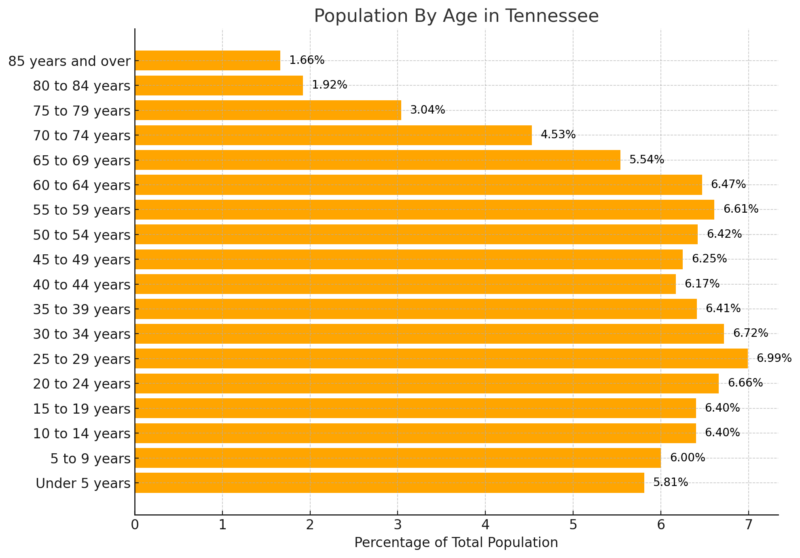
The median age in Tennessee is 38.9 years, based on the 2018–2022 ACS 5-Year Estimates.
Looking at the age breakdown, 18.21% of the population is under 15 years old, 20.05% are between 15 and 29 years, 45.05% fall into the 30 to 64 age group, 15.03% are aged 65 to 84, and 1.66% are 85 or older.
This shows a fairly balanced population with a strong working-age group and a growing senior population.
The largest age group in Tennessee is 25–29 years (6.99%), reflecting the strong presence of young adults in their peak working and reproductive years.
The smallest group is 85 years and older (1.66%), indicating a relatively small elderly population in the higher age bracket.
The population under 5 years (5.81%) shows a steady birth rate, while groups aged 70 and above collectively form a notable share, representing Tennessee’s aging trend.
Tennessee Population by Age Cohort
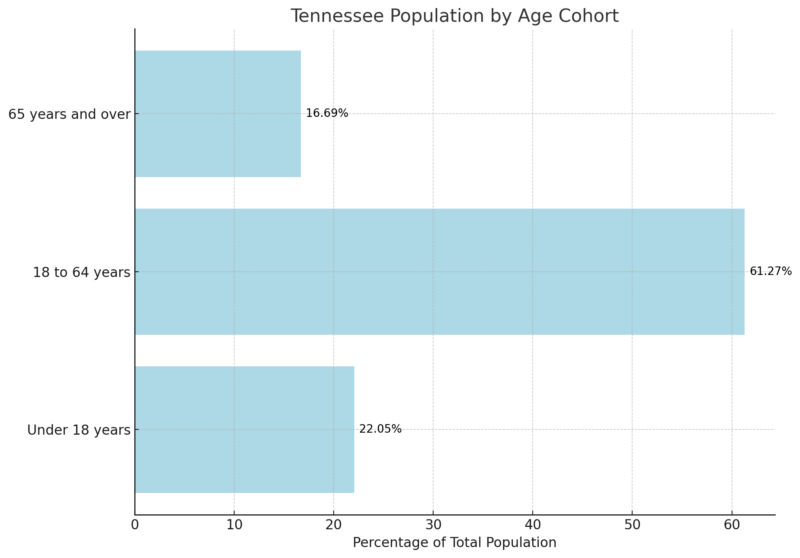
The majority of Tennessee’s population falls within the working-age group (18–64 years), comprising 61.27%.
Children under 18 account for 22.05%, showcasing a substantial youth population.
Seniors (65 and older) make up 16.69%, highlighting an aging population that may influence future healthcare and support services.
Tennessee Population by Gender
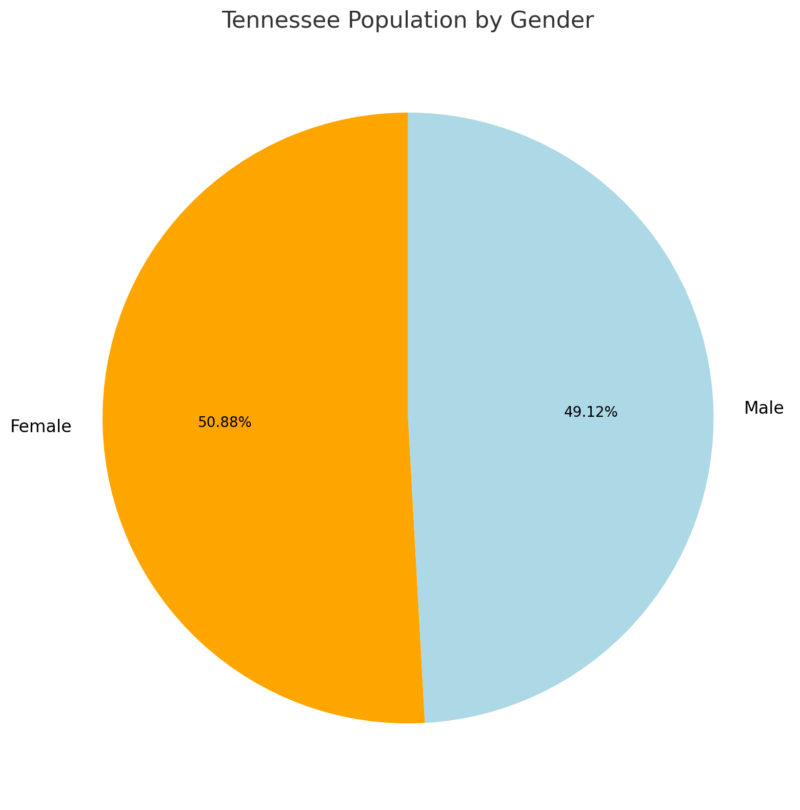
Females slightly outnumber males in Tennessee, with 50.88% of the population being female and 49.12% male as per Neilsberg’s article.
This gender distribution mirrors national trends, where females typically constitute a majority due to higher life expectancy.
Population by Race
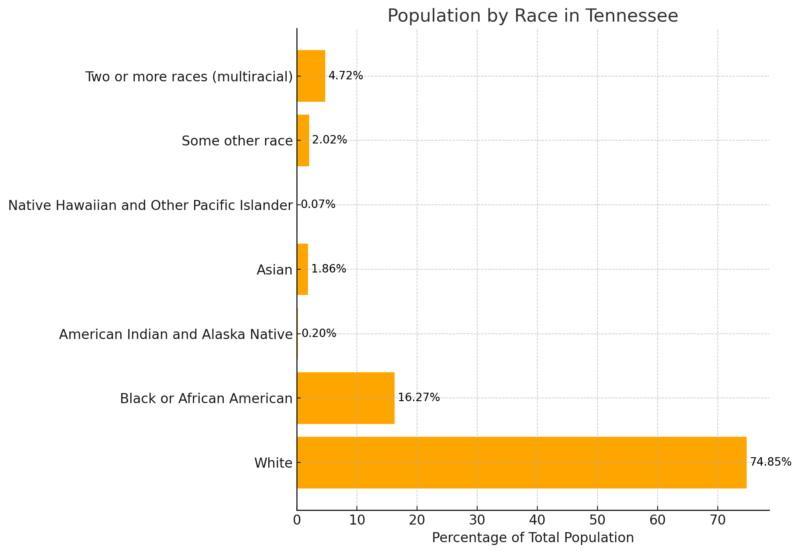
Neilsberg says that the majority of Tennessee’s population identifies as White, making up 74.85% of the total.
Black or African American residents account for 16.27%, representing the largest minority group.
Multiracial individuals (4.72%) and those identifying as “Some other race” (2.02%) together reflect a small but notable portion of the population.
Asian residents make up 1.86%, while American Indian and Alaska Native (0.20%) and Native Hawaiian and Other Pacific Islander (0.07%) communities form smaller demographic groups.
These figures indicate a predominantly White population with growing racial and ethnic diversity.
Job Market
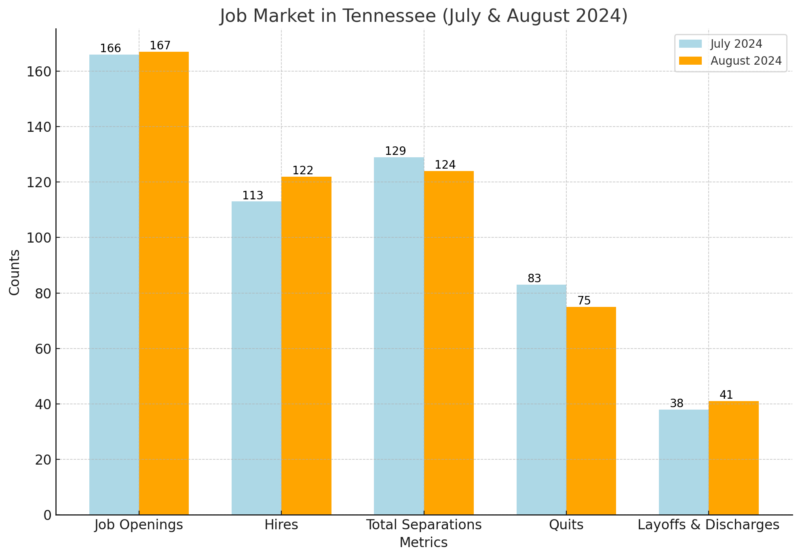
Tennessee saw a modest increase in job openings (+1,000) in August 2024, bringing the total to 167,000. Hires rose significantly by 9,000, indicating a stronger recruitment trend as per BLS.
Total separations dropped by 5,000, primarily due to a decline in quits (-8,000).
However, layoffs and discharges increased by 3,000, which could reflect localized challenges in certain sectors.
Job Openings and Labor Turnover Rates for Tennessee
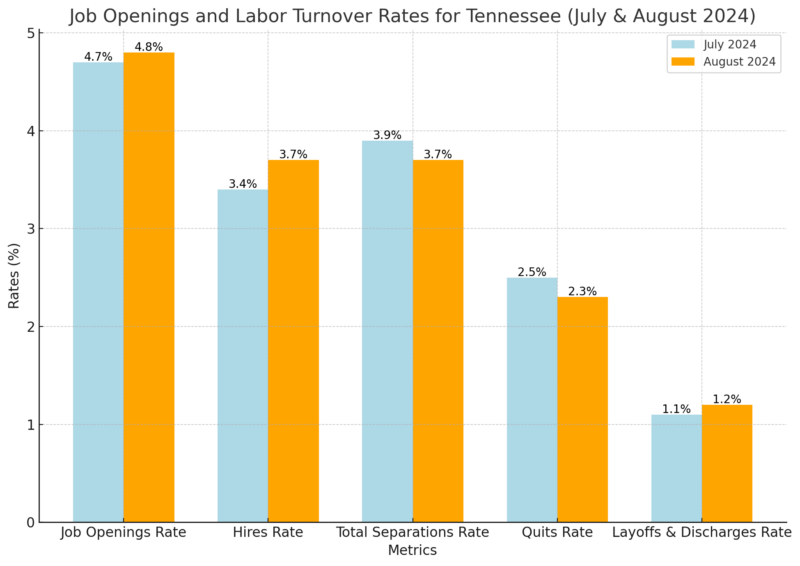
The job openings rate in Tennessee increased slightly to 4.8% in August 2024, aligning with the national rate. The hire rate rose by 0.3%, showing improved employer demand for workers. The quits rate decreased to 2.3%, signaling potentially higher job stability, while the layoffs and discharges rate edged up to 1.2%.
Comparison of Job Openings and Turnover Rates (Tennessee vs. U.S.)
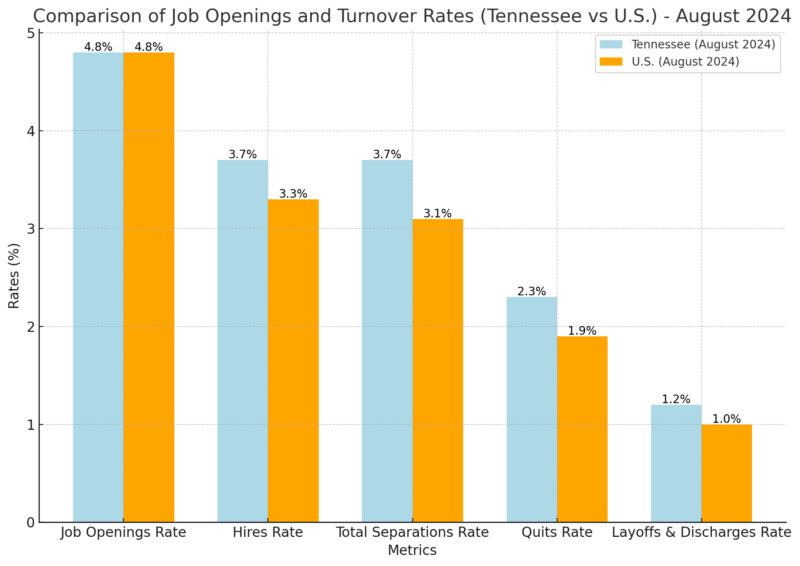
Tennessee’s job openings rate matched the national average of 4.8% in August 2024.
However, the state’s hire rate (3.7%) exceeded the national rate (3.3%), reflecting stronger job market activity in Tennessee.
Separations, including quits and layoffs, were also slightly higher in Tennessee compared to the national rates.
Ratios of Unemployed Persons Per Job Opening
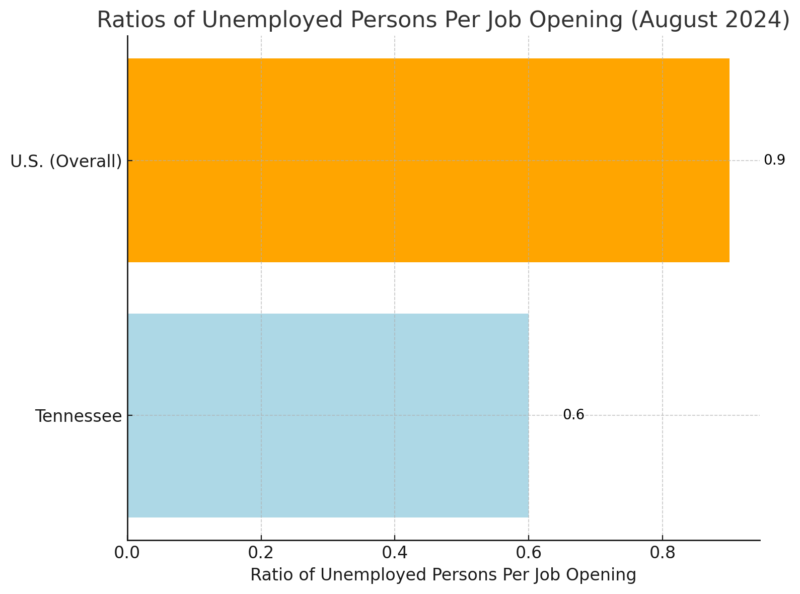
Tennessee had a ratio of 0.6 unemployed persons per job opening in August, indicating a tighter labor market compared to the national ratio of 0.9. This suggests that there are more job opportunities available relative to the number of unemployed individuals in the state.
Nearly two-thirds of Tennessee counties saw lower unemployment rates in October!
✨LEARN MORE: https://t.co/LaEHX9h716 #EconomicGrowth— TN Dept of Labor & Workforce (@Jobs4_TN) November 21, 2024
Tennessee Income Statistics for 2025
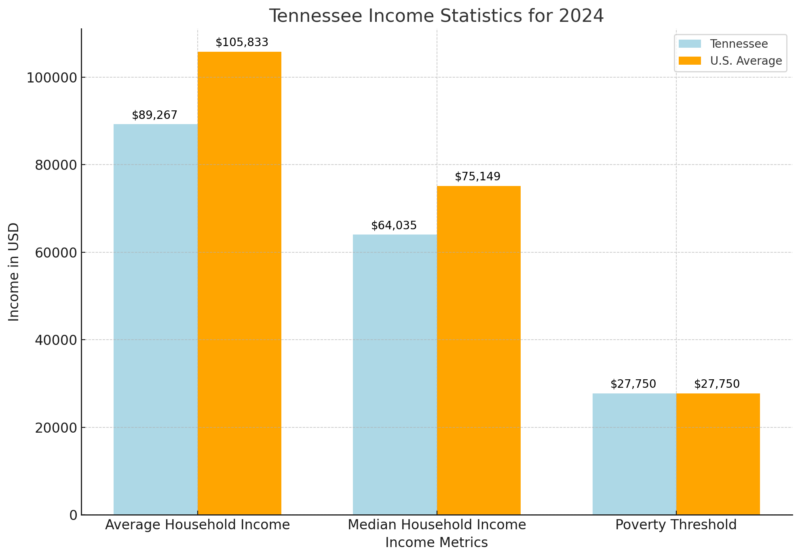
Tennessee households earn an average income of $89,267, which is 16% below the national average of $105,833 as per stated by research of Income By Zip Code.
Similarly, the median household income is $64,035, 15% lower than the U.S. median of $75,149. This indicates that while Tennessee’s cost of living is lower than the national average, income levels remain proportionately modest.
Richest Zip Codes in Tennessee
Rank
Zip Code
Population
Mean Income
Median Household Income
1
37350
2,128
$289,852
$181,458
2
38139
16,627
$240,136
$174,396
3
37220
6,153
$230,199
$150,132
4
37205
25,711
$222,323
$136,100
5
37027
62,116
$219,549
$148,564
6
37215
22,363
$217,318
$148,074
7
37069
19,571
$215,308
$141,032
8
38120
13,554
$212,769
$112,700
9
37046
6,674
$202,675
$155,224
10
38028
7,576
$187,394
$136,779
The wealthiest zip code in Tennessee is 37350, with an average household income of $289,852. Zip codes 38139 and 37220 follow, with average incomes of $240,136 and $230,199, respectively. These areas reflect high economic prosperity, concentrated around affluent neighborhoods with smaller populations.
Salary Data
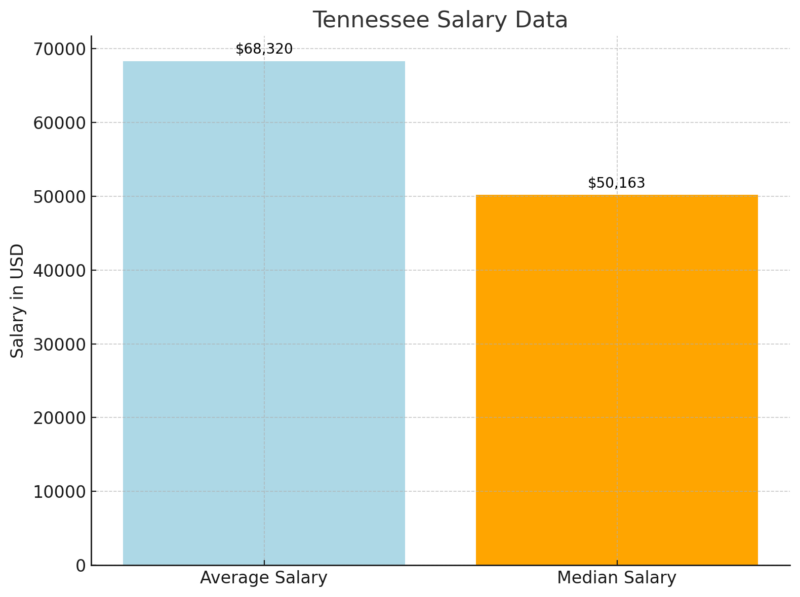
The average salary for full-time workers in Tennessee is $68,320, while the median salary is $50,163. This gap reflects income inequality, as higher earners push the average above the median. The inclusion of self-employed workers in the dataset provides a broader view of earnings across the state.
Individual and Family Income
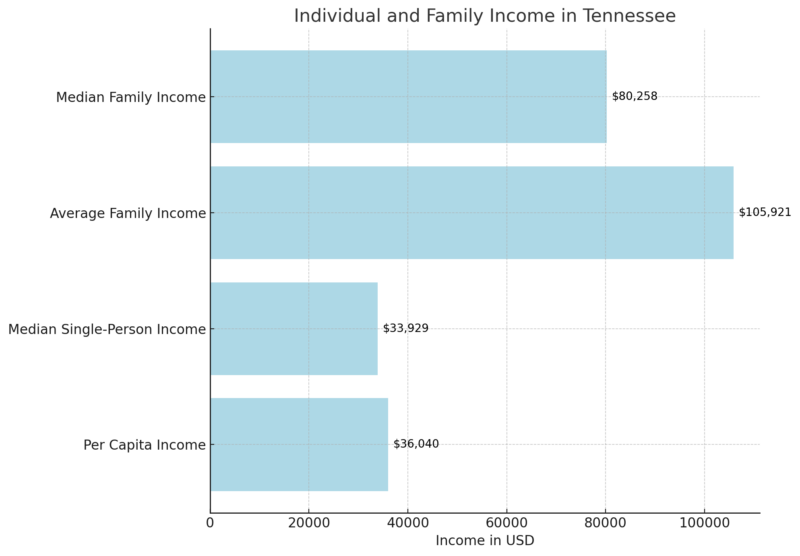
The average family income in Tennessee is $105,921, which is higher than the state’s household average due to multiple earners contributing. Single-person households have a median income of $33,929, reflecting the economic challenges faced by individuals relying on a single income.
Tennessee Housing Market Overview
Metric
October 2024
Growth (YoY)
Median Sale Price
$389,200
+5.9%
Number of Homes Sold
7,389
+2.5%
Median Days on Market
58
+5 days
Redfin notes that home prices in Tennessee have risen by 5.9% year-over-year, with a median sale price of $389,200.
The number of homes sold has increased by 2.5%, indicating steady demand despite higher prices.
Homes are taking 58 days to sell, which is 5 days longer than last year, reflecting a slightly slower pace of sales compared to previous months.
Fastest Growing Sales Prices in Tennessee Metro Areas
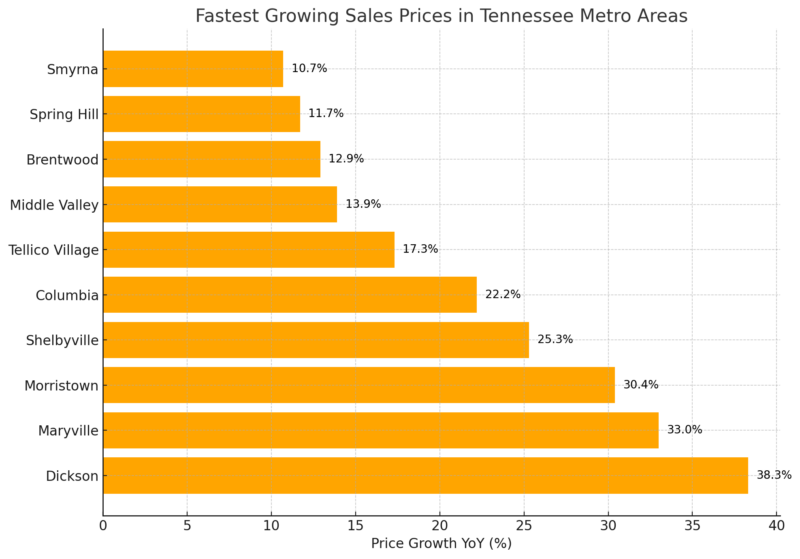
Dickson, TN has seen the largest surge in home prices, with an impressive 38.3% increase in the past year.
Other areas like Maryville (33.0%) and Morristown (30.4%) are also experiencing substantial price growth.
These trends reflect increasing buyer demand in these specific regions, potentially due to factors like local economic development or increased desirability for suburban living.
Housing Supply in Tennessee
Metric
October 2024
Growth (YoY)
Number of Homes for Sale
39,344
+18.5%
Number of Newly Listed Homes
9,528
+6.9%
Months of Supply
4
0
There were 39,344 homes available for sale in Tennessee in October, reflecting an 18.5% increase compared to the previous year.
This increase in housing supply suggests that more homes are becoming available to meet the rising demand.
The months of supply remain at 4 months, indicating that while inventory has increased, the market is still relatively balanced with homes selling at a consistent pace.
Housing Demand in Tennessee
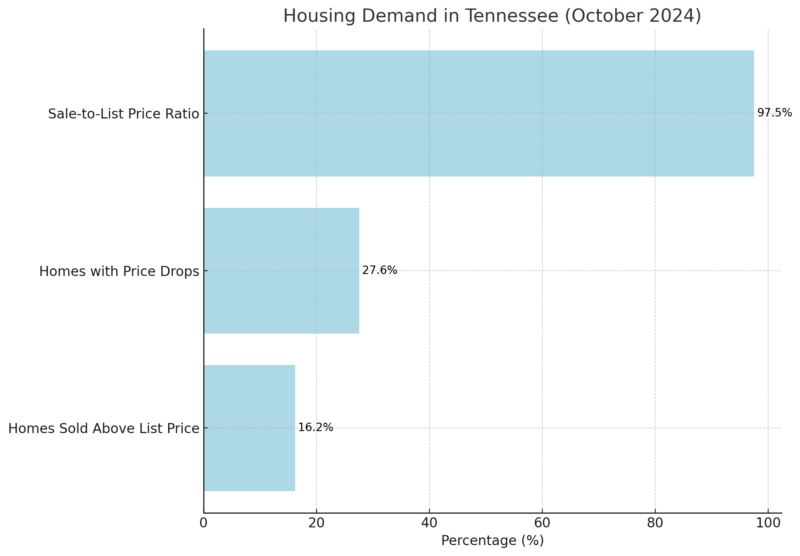
In October 2024, 16.2% of homes sold above list price, which is a decrease of 3.1 percentage points compared to last year, suggesting a slight cooling of bidding wars.
The sale-to-list price ratio is 97.5%, a decrease of 0.28 points, meaning that homes are, on average, selling closer to their asking prices but still slightly below.
The percentage of homes with price drops is 27.6%, showing that a significant portion of homes on the market are adjusting their prices in response to market conditions.
Counties by Population in Tennessee 2025
County Name
Population
County Name
Population
Shelby County
903,727
Madison County
99,214
Davidson County
717,317
Putnam County
85,218
Knox County
505,958
Anderson County
81,539
Hamilton County
385,126
Robertson County
78,154
Rutherford County
373,520
Greene County
73,862
Williamson County
268,182
Hamblen County
67,265
Montgomery County
244,845
Cumberland County
66,038
Sumner County
212,267
Loudon County
62,938
Wilson County
168,755
Tipton County
62,380
Sullivan County
163,408
Coffee County
61,487
Blount County
143,102
Hawkins County
59,297
Washington County
140,693
Jefferson County
59,016
Maury County
113,524
Dickson County
57,731
Bradley County
112,619
Carter County
57,559
Sevier County
100,024
Roane County
57,063
Madison County
99,214
McMinn County
56,661
Putnam County
85,218
Bedford County
54,146
Anderson County
81,539
Gibson County
51,264
Robertson County
78,154
Monroe County
49,508
Greene County
73,862
Lawrence County
46,726
Hamblen County
67,265
Franklin County
45,189
Cumberland County
66,038
Fayette County
45,012
Loudon County
62,938
Warren County
43,275
Tipton County
62,380
Cheatham County
42,744
Coffee County
61,487
Campbell County
40,882
Hawkins County
59,297
Marshall County
38,065
Jefferson County
59,016
Cocke County
37,959
Dickson County
57,731
Dyer County
36,556
Carter County
57,559
Lincoln County
36,332
Roane County
57,063
Rhea County
34,159
McMinn County
56,661
Weakley County
33,125
Bedford County
54,146
Claiborne County
32,951
Gibson County
51,264
Henry County
32,726
Monroe County
49,508
Giles County
30,902
Lawrence County
46,726
Obion County
30,448
Franklin County
45,189
Marion County
29,714
Fayette County
45,012
White County
29,384
Warren County
43,275
Carroll County
29,302
Cheatham County
42,744
Henderson County
28,233
Campbell County
40,882
Hardin County
27,393
Marshall County
38,065
Macon County
27,372
Cocke County
37,959
McNairy County
26,333
Dyer County
36,556
Hickman County
26,171
Lincoln County
36,332
Hardeman County
25,623
Rhea County
34,159
Grainger County
25,177
Weakley County
33,125
Lauderdale County
24,479
Claiborne County
32,951
Overton County
23,661
Henry County
32,726
Scott County
22,343
Giles County
30,902
Morgan County
21,939
Obion County
30,448
DeKalb County
21,448
Marion County
29,714
Union County
21,009
White County
29,384
Smith County
20,606
Carroll County
29,302
Fentress County
20,057
Henderson County
28,233
Humphreys County
19,395
Hardin County
27,393
Johnson County
18,704
Macon County
27,372
Polk County
18,288
McNairy County
26,333
Unicoi County
17,921
Hickman County
26,171
Chester County
17,654
Hardeman County
25,623
Sequatchie County
17,404
Grainger County
25,177
Haywood County
17,138
Lauderdale County
24,479
Benton County
16,212
Overton County
23,661
Wayne County
15,866
Scott County
22,343
Cannon County
15,319
Morgan County
21,939
Bledsoe County
15,296
DeKalb County
21,448
Stewart County
14,450
Union County
21,009
Grundy County
14,131
Smith County
20,606
Meigs County
14,124
Fentress County
20,057
Crockett County
14,102
Humphreys County
19,395
Lewis County
13,220
Johnson County
18,704
Jackson County
12,711
Polk County
18,288
Trousdale County
12,465
Unicoi County
17,921
Decatur County
11,763
Chester County
17,654
Perry County
9,077
Sequatchie County
17,404
Houston County
8,539
Haywood County
17,138
Clay County
7,772
Benton County
16,212
Hancock County
7,066
Wayne County
15,866
Moore County
6,780
Cannon County
15,319
Van Buren County
6,556
Bledsoe County
15,296
Lake County
6,194
Stewart County
14,450
Pickett County
5,153
WPR notes that in 2019, Shelby County, home to Memphis, was Tennessee’s most populous county with 936,961 residents, showing a slight growth of 0.91% since 2010. Other large counties include Davidson (691,243), Knox (461,860), Hamilton (361,613), and Rutherford (317,157), with Rutherford growing the most at 20.25%.
Pickett County, the least populated, has just 5,073 residents, with several counties like Van Buren and Moore also under 10,000. Many of these counties have seen population declines, especially Lake County, which lost 4.60%.
Trousdale County had the highest growth rate at 28.05%, followed by Rutherford (20.25%), Wilson (18.98%), and Montgomery (15.60%). Lauderdale County experienced the greatest loss, down 8.82%.
Immigrant Population in Tennessee
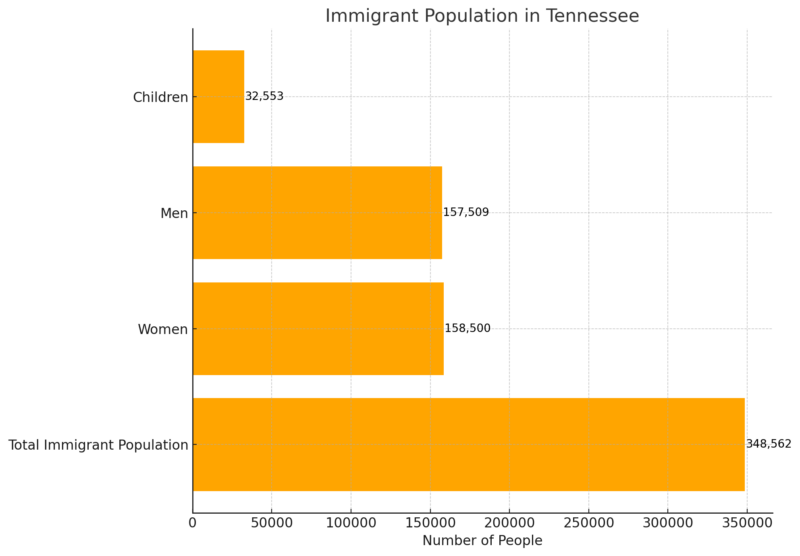
Tennessee’s immigrant population made up 5% of the state’s total in 2018, with significant representation from Mexico (24%) as per the American Immigration Council.
The majority of immigrants are adults, with nearly equal numbers of men and women, and a smaller portion are children.
Additionally, 4% of residents are U.S.-born with at least one immigrant parent.
Immigrants come from various countries, with India, Honduras, China, and Egypt also contributing notable percentages.

Immigrant Naturalization and English Proficiency
Category
Number
Percentage
Naturalized Immigrants
140,557
40%
Eligible for Naturalization
60,484
–
Immigrants Speaking English Well
–
77%
About 40% of immigrants in Tennessee have naturalized as U.S. citizens, with another 60,484 eligible for naturalization.
Additionally, 77% of immigrants in Tennessee report speaking English “well” or “very well,” indicating a high level of language proficiency among the immigrant population.
Educational Attainment of Immigrants vs. Natives
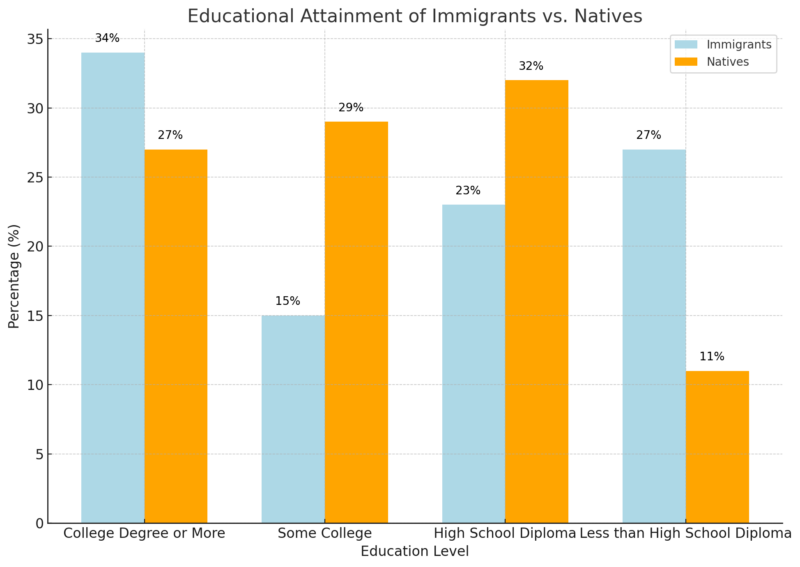
Immigrants in Tennessee have a higher percentage of individuals with a college degree or more (34%) compared to native-born residents (27%).
However, a significant portion of immigrants (27%) have less than a high school diploma, which is much higher than the native-born population (11%).
This indicates a wider range of educational backgrounds among immigrants.
Immigrant Workforce Participation
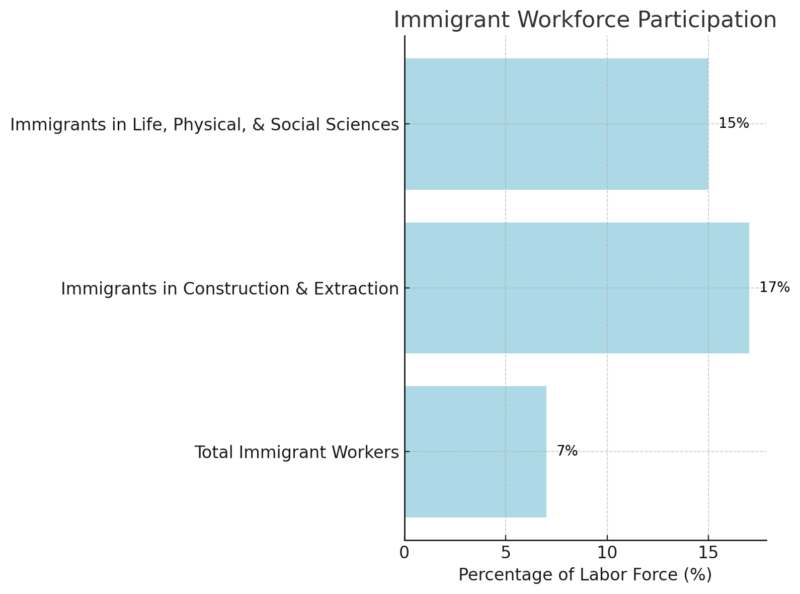
They represent 7% of Tennessee’s labor force, with significant concentrations in construction (17%) and life, physical, and social sciences (15%).
These numbers highlight the critical role immigrants play in Tennessee’s economy, particularly in skilled labor and scientific fields.
Methodology
This article was crafted using data from various official and research-based sources, including U.S. Census Bureau estimates and the American Community Survey (ACS).
Key population and workforce statistics were summarized to highlight trends and demographic shifts.
The content was structured to provide a concise overview of Tennessee’s growth, economic indicators, and immigrant contributions.
Data points from 2025 projections, income statistics, and county comparisons were integrated for a comprehensive yet accessible summary.
The article also compared Tennessee’s metrics against national averages for context.
References
- World Population Review – Tennessee Population 2024
- Neilsberg – Tennessee Population by Age
- Neilsberg – Tennessee Population by Gender
- American Immigration Council – Immigrants in Tennessee
- U.S. Bureau of Labor Statistics – Tennessee Job Openings and Labor Turnover
- World Population Review – Tennessee Counties Population
- Income By Zip Code – Income By Zip Code
- Redfin – Tennessee Housing Market Overview








